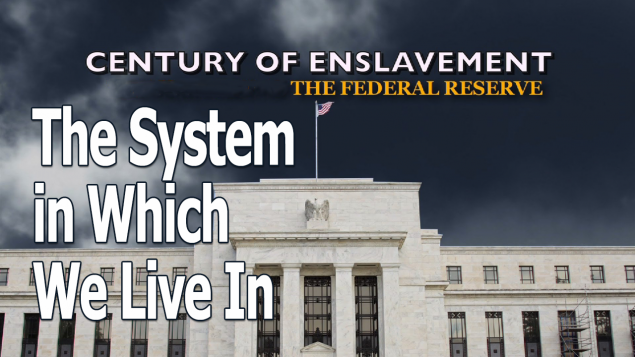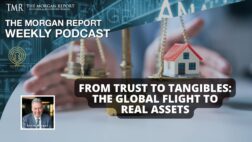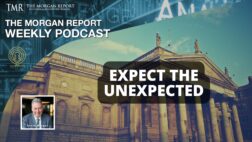- Get Trading Recommendations and Read Analysis on TheMorganReport.com for just $50 per month. | http://www.themorganreport.com/join.
- Discover How YOU Can Cash-Flow Gold & Silver For A Passive Income Of 12% – 26.4% Per Year Just Like Real Estate… Get more details here.
- Starting your own precious metals savings program is an easy way to automatically save in gold and silver. This makes it easy to maintain a disciplined program for increasing your ownership of history’s most proven stores of value. Learn more here.
The System in Which We Live In
By Jonathan (TMR Member)
Most people tend to take most things in life for granted – they never question how or why things are the way they are. Almost everyone in advanced economies these days has a car, television, mobile phone, computer, clean drinking water from a tap, and electricity. Most of us, especially the younger generation, were born into this reality. However, depending on how old you are and your geographical location, things can be quite different. Your parents and grandparents have a totally different experience. When they were younger, not everyone had a car or a television, and the thought of having a small device in your hand that can instantly connect you to anyone across the globe was something that nobody thought or even dreamed about.
One of the things that impacts us all on daily basis and most aspects of our lives, regardless of ethnicity, religion, culture, and geographical location, is money/currency. Every person needs to eat, wear clothes, have a roof over his head, have means of transportation, and countless other transactions – currency enables such things with relative ease. All currencies today are fiat (by decree) currencies issued by governments and their central banks. But that has not always been the case, and I argue that such currencies are dangerous and immoral. To understand how things came to be, I’ll delve a bit in history.
Prior to currency, there was barter. Barter’s major problems was that you had to be at the right place and time to find someone else who wanted to trade his goods or services for yours. Currency solved that problem, and helped facilitate trade and investment, thereby enabling larger economic activity and increased production. Throughout history, across borders, centuries, and cultures, gold and silver emerged as a superior form of currency, as they were able to be a store of value of long periods of time, measured in decades, centuries, and millenniums.
However, on occasions, there were also paper currencies, which in some places started as a receipt of the thing of value (gold and silver), but they were short lived, as they weren’t a reliable store of value. Paper currency was and is abused by politicians and banks, which eventually devalue the currency, causing the general public to lose purchasing power, thus reducing the overall prosperity of a society. While theoretically paper currency can be managed responsibly, history has shown time and again, that is never the case. The temptation to paper over problems rather than solving them and letting the free market determine winners and losers, is simply too great for most people. This is especially true of politicians, who want to get re-elected, and the various powerful special interest groups which are attracted to political power and influence it for their own advantage, usually at the expense of the public.
Most people, myself included at one point, view currency/money as wealth. After researching the subject for a prolonged period of time, I came to a conclusion that the proper way to view wealth is tangible items/goods and services provided by society’s members. Currency, is a claim (or representation) on wealth, and some currencies do and have done a better job at preserving that claim, allowing to store economic energy over long periods of a time until a person wishes to use it, thereby translating a claim on wealth (whether it is paper currency or precious metal) into real wealth, such as a house, car, farmland, gym membership, etc. Creating more currency units does not increase wealth – it merely increases the claims/representations on real tangible items and services. A prosperous society is one with enhanced production capability, thus increasing the claim each currency unit has on real wealth (prices go down)
The public at large does not know or taught how currency is created. There are two ways it is created: by the Federal Reserve (central bank) and fractional reserve banking.
Federal Reserve (central bank) Currency Creation Process:
- The government’s treasury issues a bond which is a piece of paper stating it owes X amount of dollars plus interest for a certain period of time Y.
- Thru a process called bond auction, certain banks (primary dealers) are allowed to buy bonds from the treasury and sell it to the Federal Reserve.
- The Federal Reserve prints physical notes or inputs a bunch of numbers into a computer program and swaps the newly created currency with the treasury’s bond (I.O.U), using the primary dealers as a middleman.
- After a period of time Y passes, the treasury must pay the principal amount plus interest back to the central bank. Since the total amount it owes is greater than the amount of currency previously created, it must borrow more currency into existence to pay the interest and the processes repeats itself again.
- The Federal Reserve remits some of the interest profit to the treasury and some is disburses as dividends to its private shareholders. Yes! This perpetual debt design guarantees that large currency amounts end up in some people’s pocket.
Fractional Reserve Banking
If I had a ten dollar bill and loaned it to a friend of mine, he would be able to purchase goods for ten dollars but I would lose that purchasing power until he returns me the ten dollars. Banks, however, have been given enormous power. When a typical loan such as a mortgage or automobile loan is made, the bank doesn’t really loan you another depositor’s currency. Instead, it creates new currency and the debt associated with it, for which you have to pay back with interest. That currency can be deposited into another bank and the process repeats. There is a limit to how much currency can be created out of thin air, but it is quite small and allows for a great expansion of the currency supply, and the debt which is associated with it.
These two processes of currency creation increase the currency supply faster than the production capability of a society, thus increasing the ratio of currency to goods and services. As long as the public’s psychology remains “calm”, this translates into price increases and reduced standards of living for the general public. However, the banks and special interest groups get a larger share of the currency in existence, thus they are enriching themselves at the expense of the public. Those who receive the currency first, such as financial institutions and the military industrial complex (and other special interest groups the government favors), can use the currency first and purchase goods prior to new currency supply being absorbed in the market. By the time the new currency supply is absorbed in the market, price increases occur and the public’s standards of living are decreased.
Wealth cannot be printed out of thin air or by typing a bunch of numbers on a keyboard in front of a computer screen. A good way to visualize this is to imagine a large pie that everyone has certain shares in it, represented by a form of currency. Merely increasing the currency supply does not enlarge the pie and make everyone wealthier. The pie, in real life, is the goods and services that society provides. A wealthy and prosperous society is one that can enlarge the pie without increasing the currency (shares), thereby having everyone have claim (currency) on a bigger share. Governments and banks provide currency to special interest groups, thereby enlarging their part of the pie at the expense of the public – they do not make the pie any bigger. Fiat currency, allows government and banks to provide an illusion of wealth to the public, which is not knowledgeable about such matters.
The public at large does not understand that here, in the United States, the official and public policy of the central bank, the Federal Reserve, is to have 2% annual inflation rate. It wants to decrease the purchasing power of the general population in order to allow the big government to service its debt more easily. In a sense, it is the equivalent of additional 2% tax on each person’s existing savings and future earnings, on yearly basis. However, since that explicit language is not used, it is lost on most people who come to think of inflation as something that is naturally occurring, and not achieved by directed policy and mismanagement.
The ability of governments and central banks to transfer wealth (purchasing power) is the main reason for reduced standards of living and inequality gap. There are other factors such as financial institutions de-risking themselves by “gambling” with other people’s money and being bailed out by central banks, but that is a different topic I won’t get into.
The reduced standards of living, inequality gap, and financial crisis are the most spoken of symptoms of such a system. Although the economic cost to society is often spoken of, I feel that there is another cost which is rarely if ever mentioned. Such a system makes wars much more likely, as it hides and defers the true economic cost of wars, thereby enabling more of them. The human cost of war, which is enabled by such a system, is rarely spoken of, and the connection between the monetary system to war is lost on most people. If a sound money monetary system would be in place, wars would truly have to have the backing of the people – there would have to be a really good reason for them to sacrifice their purchasing power and lower their standards of living.
Because there is a 100% failure rate of ALL fiat money throughout history, you will learn what to do by obtaining your Free Report. Just enter your first name, your primary email address and click the Get Special Report button below.
Our mission statement reads… “To teach and empower people to understand the benefits of an honest monetary system.”
Today’s monetary system is based upon a lie. The lie is that you can get something for nothing, or perhaps more simply stated, wealth can be printed. History has shown throughout 5000 years that whenever a country has tried to maintain this illusion (lie), failure has been the result. We invite you to learn more about what The Morgan Report can do for you. Click on the Learn More About The Morgan Report button now!




